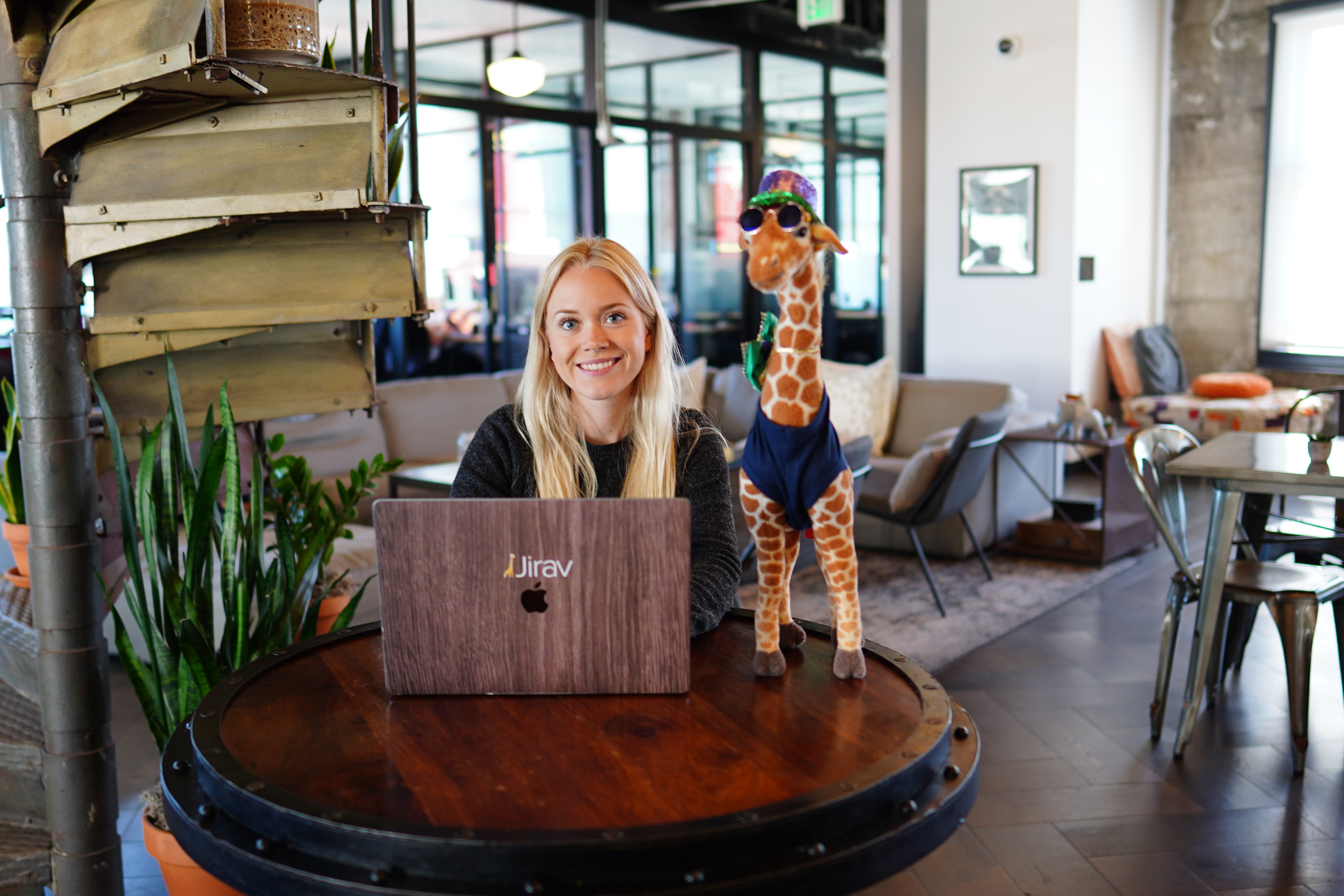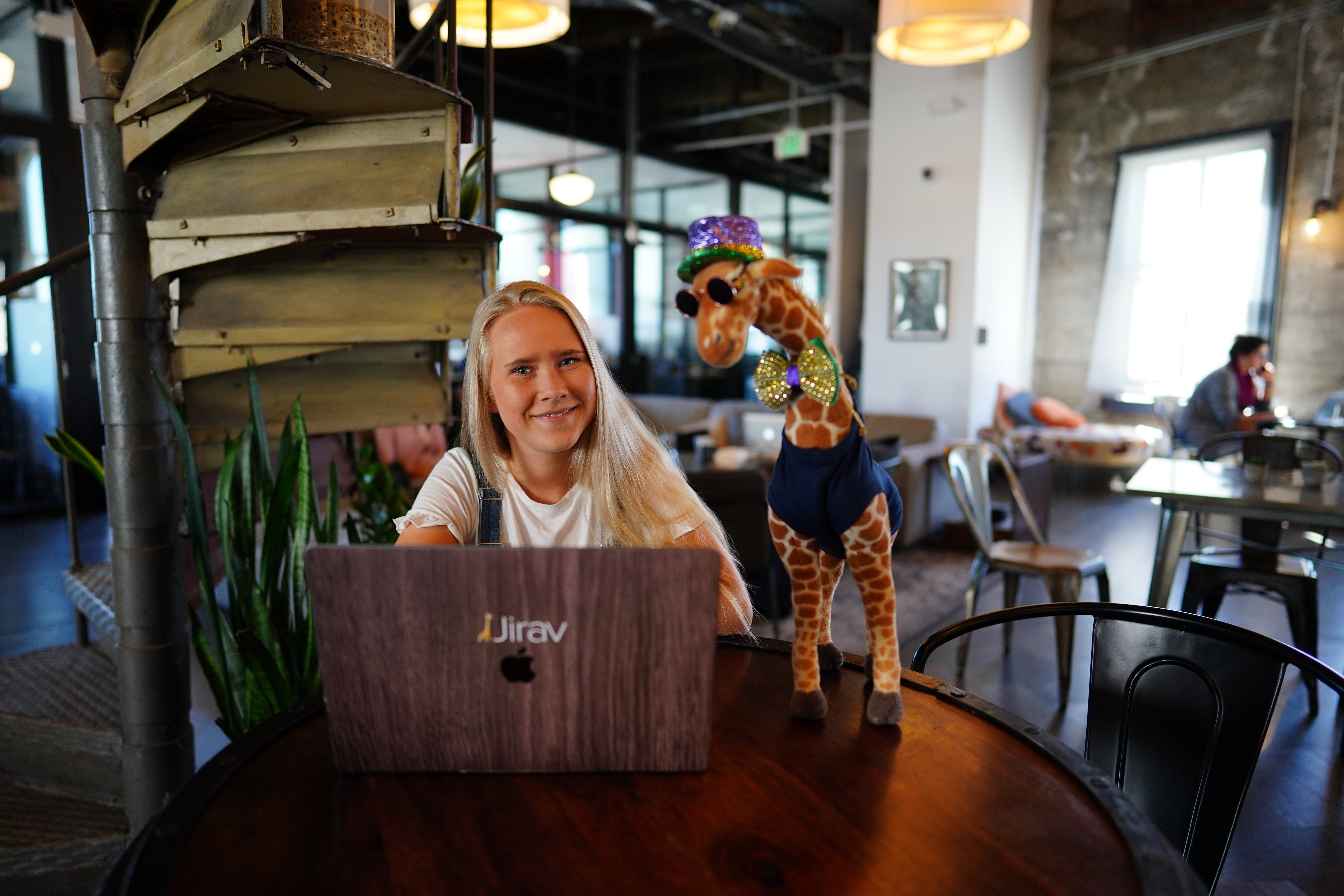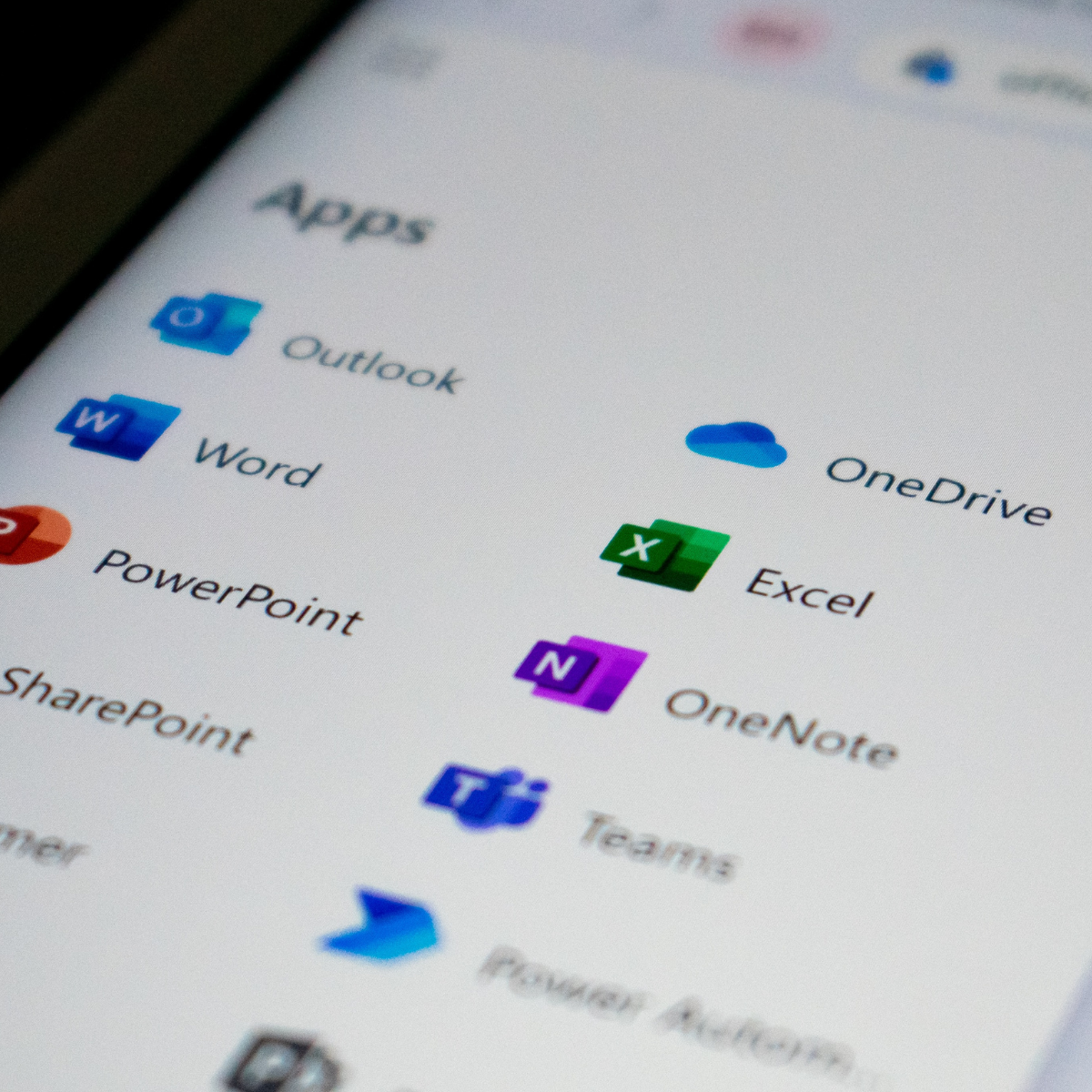About Julie
My name is Julie, I'm from Norway and an intern in Jirav for the summer. My internship is a part of my participation at Norwegian School of Entrepreneurship, which is a program lasting for ten weeks and includes an internship and a course at UC Berkeley. Over this period, I´ve created a demo account for Jirav which will be used as an example firm and as a framework for customers of Jirav. Back home I'm a student at Norwegian School of Economics and currently doing a Master of Science in Business Administration with a major in finance.
About Panda Partners

Panda Partners is representing a small accounting firm helping S&M businesses track and manage their finances. They are based in one US city, Boston, and aiming to grow in terms of higher efficiency and more services for their clients.
They're initially offering bookkeeping and hourly consultation, and from January 2019 they also offer budgeting. Thus, their revenue model consists of monthly subscription for the two services as well as hourly fee for the consultation service.
The financial model starts in 2018 with 3 employees; one management partner, one controller and one bookkeeper and 30 clients in total. In January next year, 2019, they start offering a budgeting tier. They also hire one new controller and a new bookkeeper as they start to scale their practice. In 2020 they start using Jirav lite for their bookkeeping clients and they start using Jirav pro for budgeting. They also hire a CFO along with a sales manager and marketing manager and a support staff. They also start using Jirav as a tool for financial modeling making their service more complete and highly efficient. Their main costs are wages and related costs for their employees and subscription fees. The model ends in 2022, where total revenue has increased dramatically due to more clients and more services. In addition, revenue per employee has also increased a lot, which is indicating more efficiency.
Key events
- Jan 2019 - Budgeting tier offered on top of Bookkeeping tier
- Jan 2020 - Jirav for Lite as well as Pro, increased hiring, scaling
- Jan 2020 - improvements in KPIs across the board
Dashboard
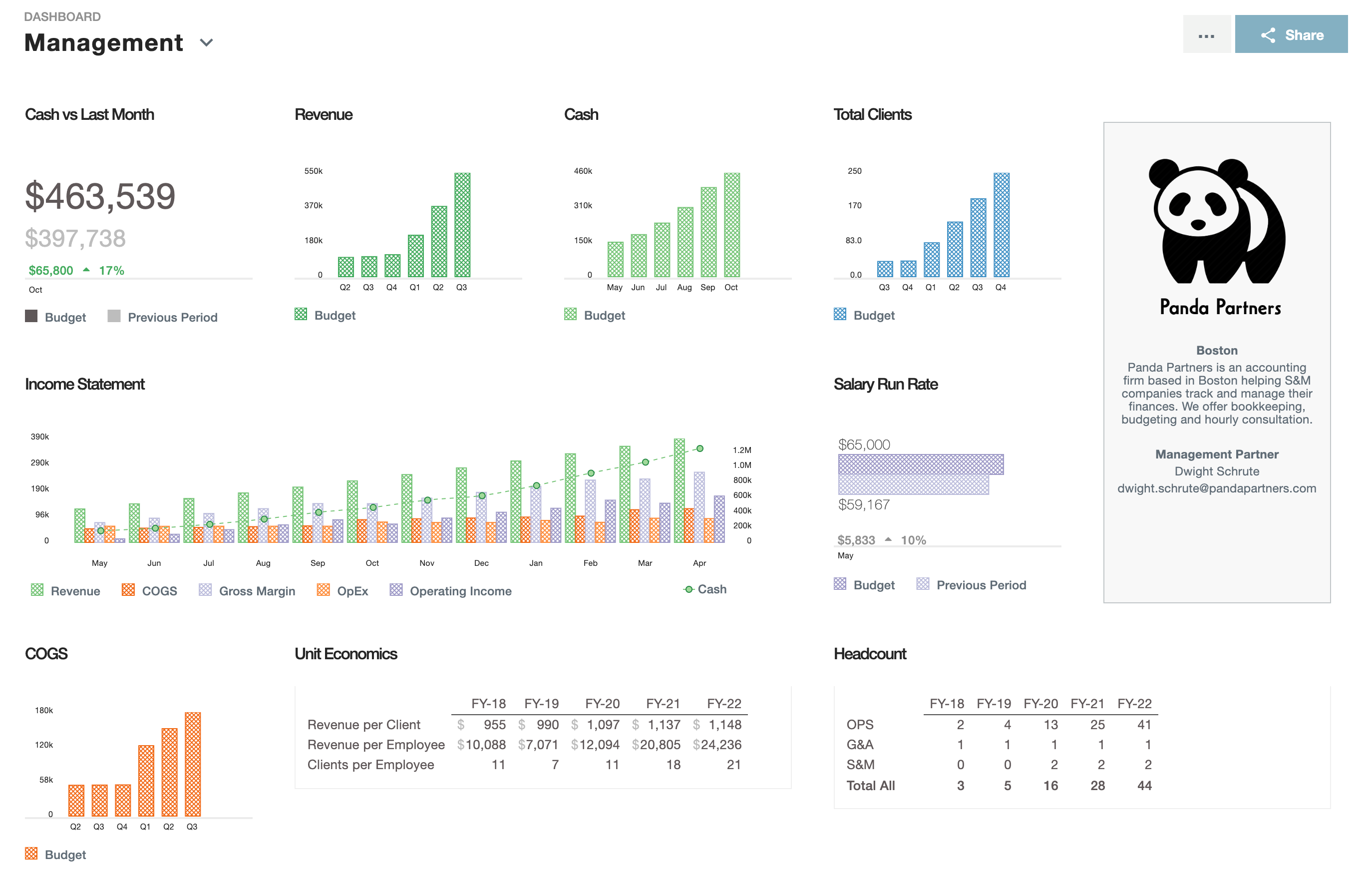
On the Management Dashboard the first tile is showing us that cash is higher than last month and also increases over time. As Total Clients go up over the period, so does Revenue. The COGS also goes up over time, but in the Income Statement we can see that overall the Gross Margin and Operating Income is increasing due to higher increase for revenue than COGS.
The Headcount tile displays how the company is adding more staff and in which department they belong. Salaries for close month is higher than for the previous month.
The table with Unit Economics is showing us three important key metrics. We see an overall increase in revenue per client, which is very positive. Furthermore, revenue per employee and clients per employee goes up over time, which indicates higher efficiency in the use of the company's resources.
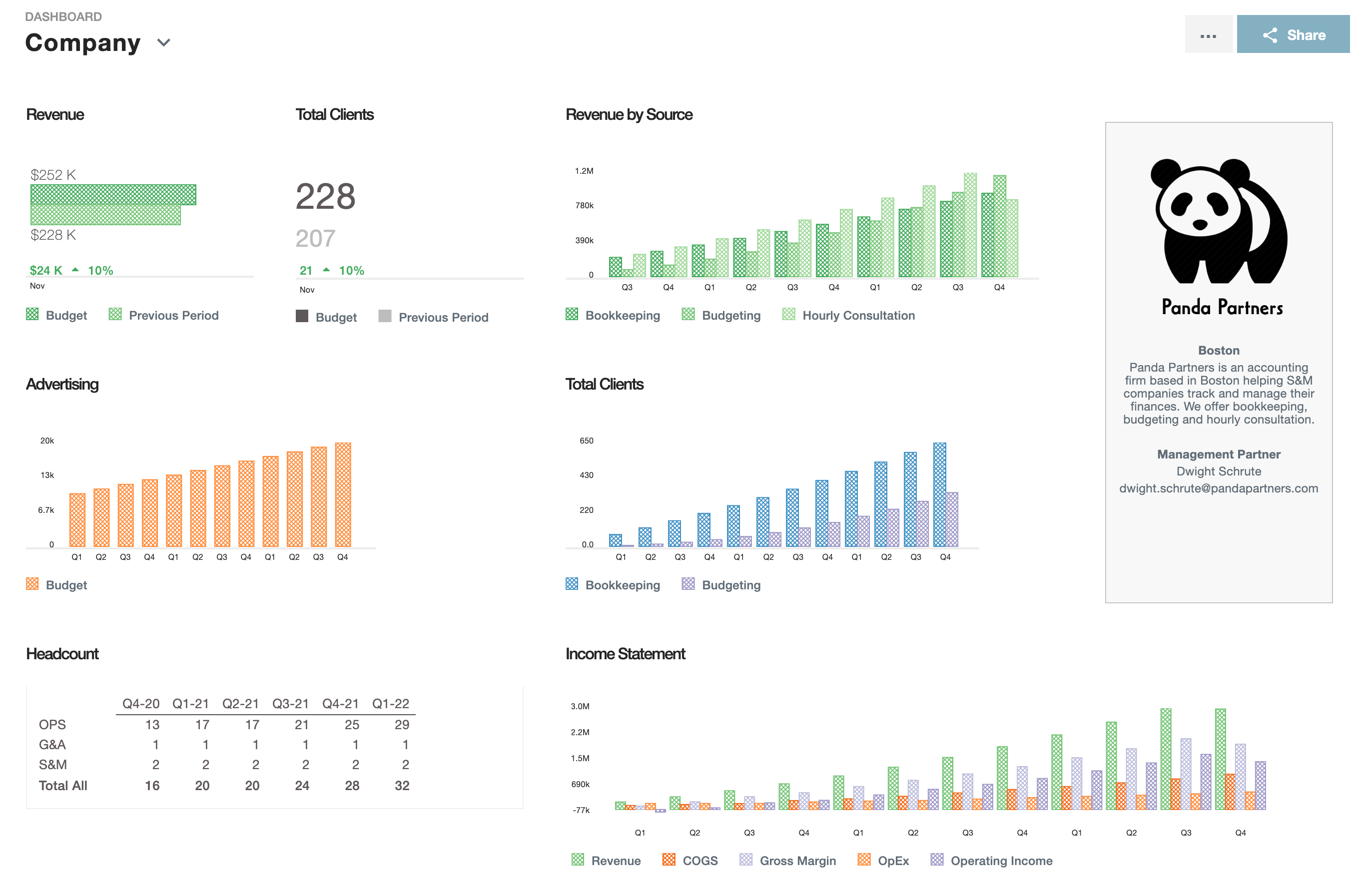
In the Company Dashboard we can see that revenue increases from the previous period. Total revenue by source is also displayed and it has a positive growth over time, but the growth is slightly different for the three revenue sources.
Advertising expenses are increasing over time and so is total clients, with an increase of 21 from the previous quarter. The graph to the left separates the two types of clients and we can see how the total number of clients on Budgeting is catching up with the total number of clients on Bookkeeping over time.
The number of headcount are also displayed in the company board along with the income statement, but the latter lack information about the cash amount.
Reports
We've created three reports, Monthly Package, Management and Sales. Here we'll focus on the Monthly Package which includes six reports; Executive Summary, Sales and KPIs, Income Statement, Balance Sheet, Cash Flow Statement and Workforce.
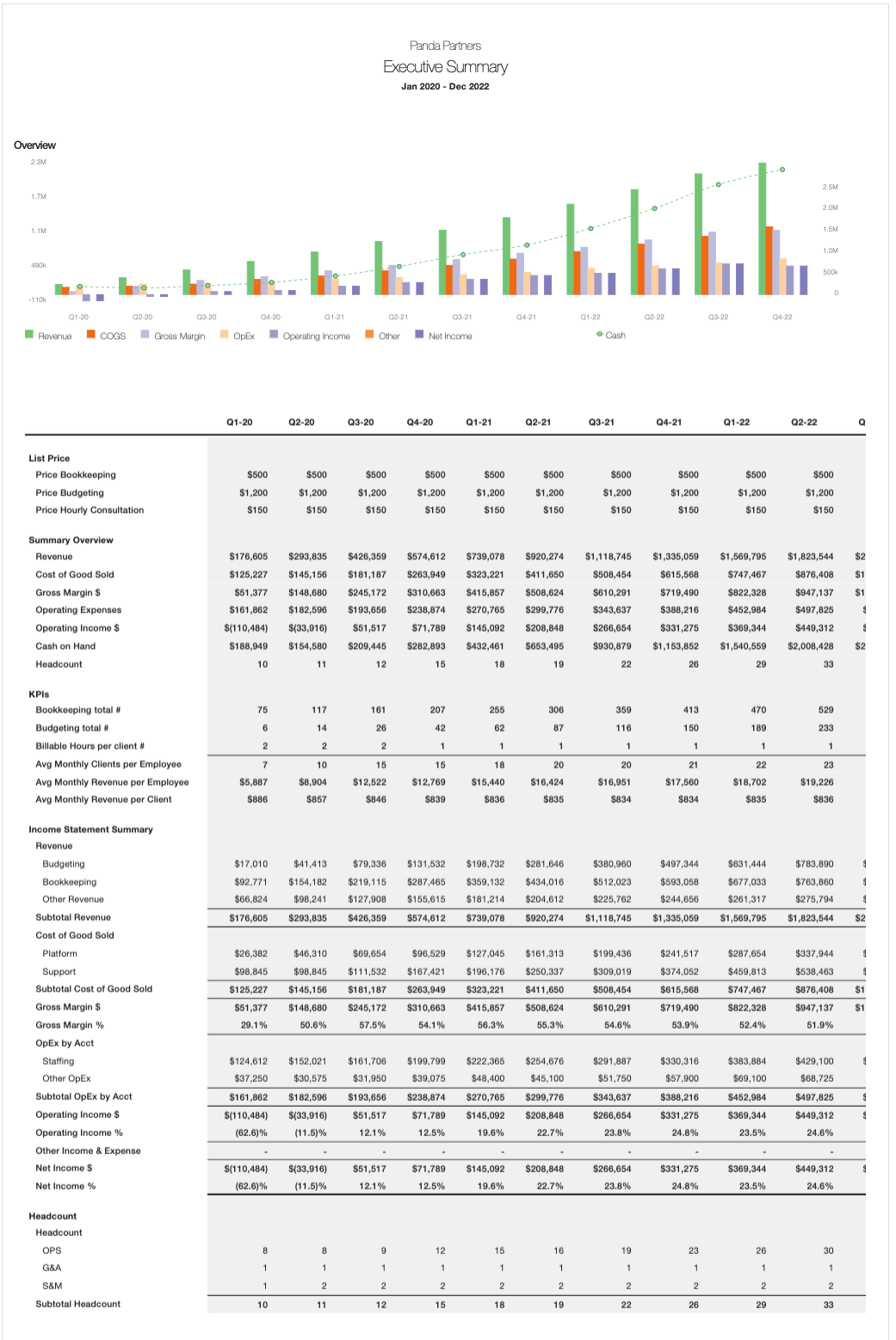
At the top we can see the prices for the three services, Bookkeeping, Budgeting and Hourly Consultation, which is respectively $500, $1200 and $150.
The summary overview provides information about revenue, COGS, gross margins, OpEx, operating income, cash and headcount overview. Both gross margins and operating income are growing over the time period. They go from 3 to 48 employees over 3 years as they introduce Budgeting, get more customers and increase marketing and sales.
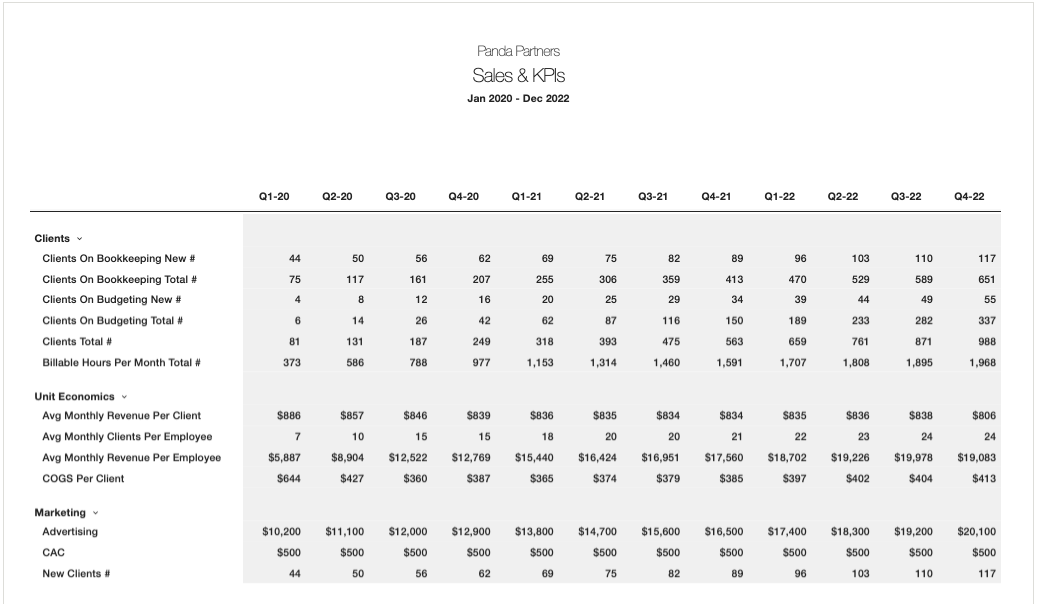
The Sales and KPI report have three sections, Clients, Unit Economics and Marketing. Clients contains total clients on monthly retainers for Bookkeeping and Budgeting and also the billable hours. Budgeting is introduced in 2019 and here we can see the Bookkeeping and Budgeting clients increase over time. Unit Economics shows efficiency, like revenue and clients per employee as well as revenue per client, where all these three numbers increase when Jirav is introduced. We also have COGS per client going down over time.
The marketing part shows the total trend in Advertising spend, the Customer Acquisition Cost (CAC) and the resulting growth in new clients.
The other reports are reports on Income Statement, Balance Sheet, Cash Flow Statement and Workforce.
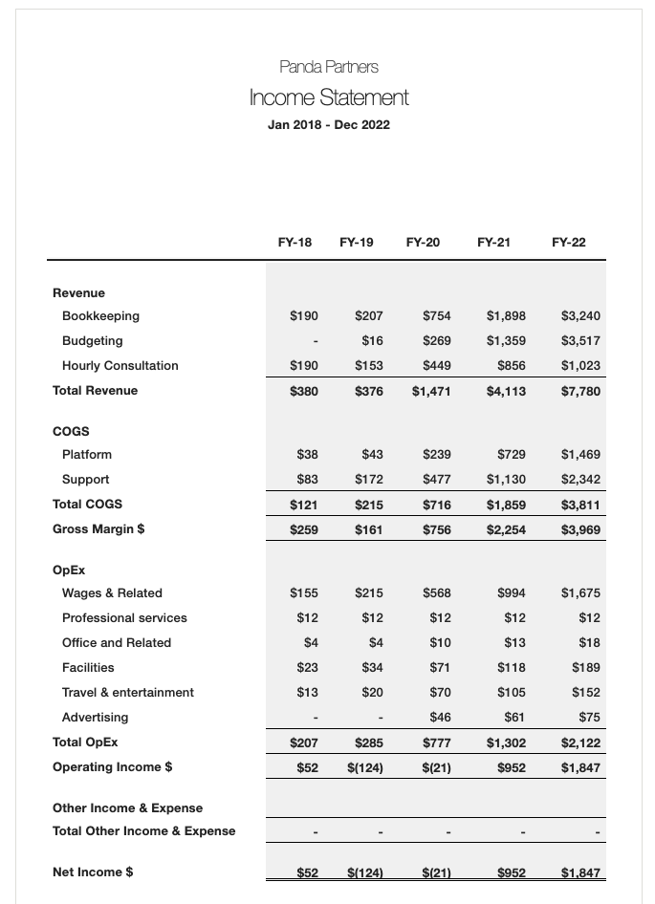
Income Statement is annual and presents the revenue sources and cost structure of the company. The COGS are Platform and Support, which are allocated wage cost from OpEx and customer support, respectively. OpEx are mainly costs related to wages, additional services like legal and subscriptions, office and facility costs. Advertising also becomes a large share of the costs in 2020.
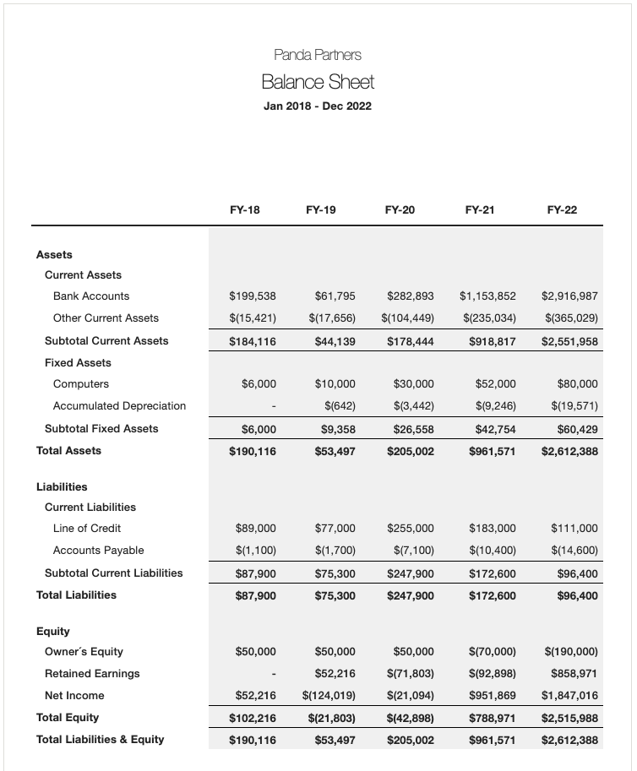
The Balance Sheet report show that their assets are cash and computers. Liabilities are one loan in 2018 and a new loan in 2020 in addition to accounts payable every month. Equity are owners contribution, net income and retained earnings, and the owner draws money in the end of every year.
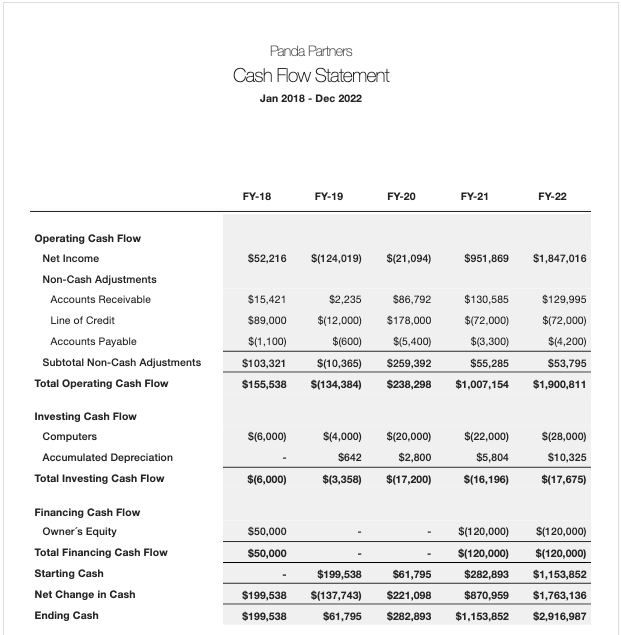
The Cash Flow Statement lists out the Operating, Investing and Financing cash flows for the company over time.
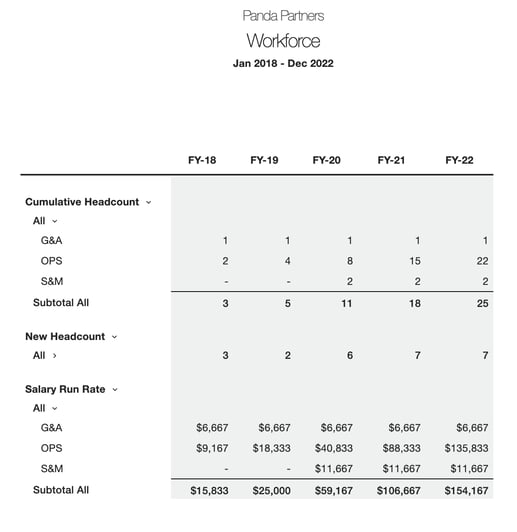
The Workforce report shows Panda Partners workforce growth over time. Sales and Marketing starts to grow in 2020, while most of the growth is in the Ops department. We can also see the salary run rate by department.
Model Build
Here's how the model is built.
Revenue
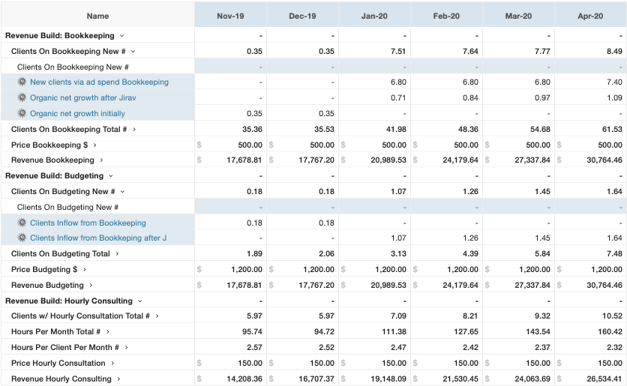
The revenue build is divided into three parts, which all corresponds to the three revenue sources; Bookkeeping, Budgeting and Hourly Consulting.
Under the fist section, Revenue Build for Bookkeeping, we can see that there are two contributions to the growth of clients, growth due to ad spend and organic growth. Advertising is introduced in 2020 and contributes to a growth of approximately 7 new clients per month. If we look at organic growth, it increases after Jirav is introduced. Furthermore, the table is showing us that price of Bookkeeping is constant, but revenue is increasing due to more clients.
Under the second section, Revenue Build for Budgeting, we have assumed that new clients of Panda Partners initially start using the Bookkeeping service only, and converts to the Budgeting service over time. The conversion jumps up after Jirav is introduced and we can see that the number of clients going from Bookkeeping to budgeting goes from 0,18 per month to 1,07 per month between December 2019 and January 2020. The Budgeting price is also constant over time, but the revenue almost doubles for Budgeting due to client growth.
The third section, Revenue Build for Hourly Consulting, we can see that number of clients using hourly consultation and consulting hours per month increases, but the hours per client goes down, slowly, due to more independence among the clients using Jirav. The price is constant also here, but revenue grows due to more clients.
Staffing



In the model Panda Partners starts out with three employees in 2018, the Management Partner, one controller and one bookkeeper. As we can see in the first table, they hire one more controller and one more bookkeeper in January 2019. In 2020 they hire a CFO as they are introducing Jirav and one Support staff. As they are starting to spend on advertising they are also hiring a Sales and Marketer Manager, where the latter starts some months later.
In the second table on the left side, the staffing roles are categorized within the different departments, G&A, S&M and OPS, and the annual wage for every role is listed on the right side.
The last table shows the drivers for the staffing plan, where the drivers are active after 2020. A controller is hired for every 100 new clients and 2 bookkeepers are hired for every new controller. Support staff are also hired for every 180 new clients, indicating that one support staff can handle 180 clients each.
OpEx
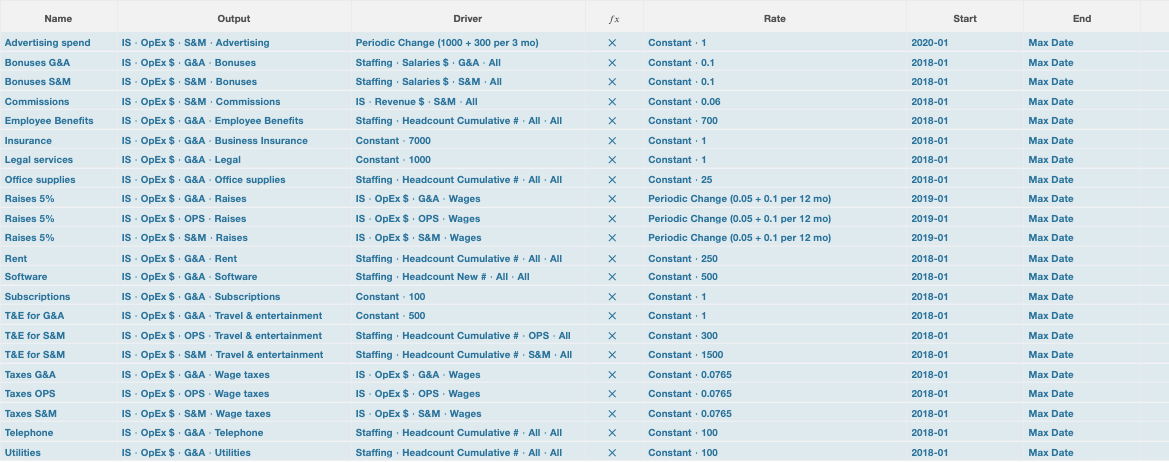
The OpEx of Panda Partners consists of the standard expenses, like advertising, wages, T&E and office rent. Some of the expenses are driven by number of headcount or wages and other are constant or has a periodic change. Most of the expenses are monthly, but there are also annually expenses, like Business Insurance of 7000.
COGS

The COGS consists of subscriptions of different services used by Panda Partners. Jirav is among these, separated into Lite and Pro version. As the start date can tell, Jirav is used by Panda Partners from January the 1st of 2020. The costs of using Jirav is much lower than the increased revenue due to Jirav, which can be seen when revenue per client goes up after 2020.
Part of COGS is also wages because the main thing sold by Panda is employee working hours. Thus, 70% of wages are allocated from OpEx to COGS as can be seen below.

Conclusion
As a first-time user of Jirav, it was quite easy to learn how the tool works. It seemed quite customizable and I was able to reflect all my assumptions easily. I also learned a lot about the business model and workings of accounting firms. The model I have built is flexible enough that it can be used for any other company with a similar business model of professional services with a retainer.
Care to try building your own financial model in Jirav? Start a free trial today:


